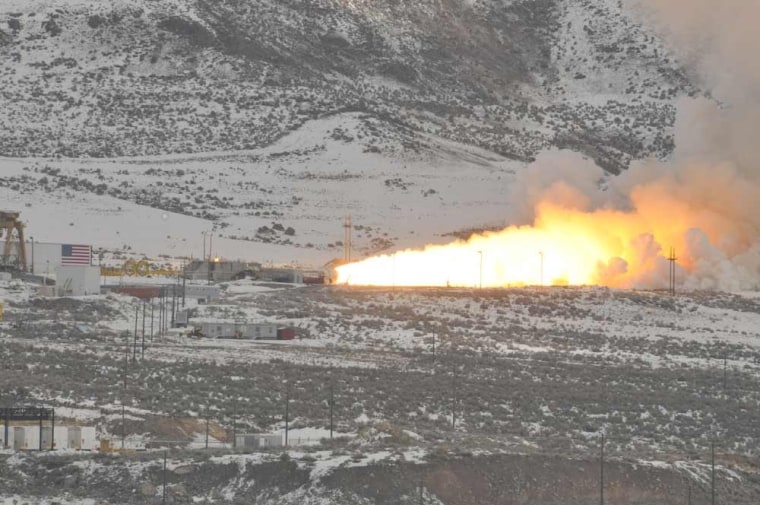The thunderous roar from a space shuttle solid rocket booster reverberating and rebounding off the mountains of northern Utah was heard for the final time Thursday, as NASA and contractor Alliant Techsystems (ATK) ignited their final ground test after three decades of static firings.
The 52nd reusable solid rocket motor (RSRM) ground test since the first was fired July 18, 1977, the two minute and three second horizontal "launch" was performed in support of NASA's remaining four missions before the shuttle fleet is retired later this year.
"That was probably the safest solid rocket motor ever test fired here," commented Steve Cash, NASA's manager for the shuttle propulsion office. "I have a lot of comfort about this coming next [four] launches because of the test firing today."
"This is really the celebration of 33 years," added David Beaman, NASA's manager for the RSRM office. "We have been testing since July 1977 here. This was the 52nd test, and the reason we test is to make sure we are safe."
A total of 43 design objectives were measured during the test, including ensuring that the final shuttle motors were safe to launch astronauts and qualifying the performance of minor upgrades to materials, according to ATK, NASA's prime contractor for the solid rocket boosters.
"I would like to report that initial test data is looking really good," Charlie Precourt, ATK's vice president and general manager for space launch systems, told the media soon after the test was completed.
The data collected from the four-segment booster test will also aid in the continued development of the five-segment booster that was to fly as the first stage for Ares, NASA's planned replacement for the shuttle. Despite being called for cancellation by President Obama earlier this month as part of the space agency's Constellation program to return astronauts to the moon, the second five-segment Ares I ground test is still scheduled for September.
Foggy firing
Thursday's final shuttle test attracted an about 5,000 public spectators, more than twice the audience for earlier firings. In addition to local schoolchildren, the test also drew in officials from across NASA's shuttle program, including a handful of former and current astronauts who rode the solid rocket boosters to space.
"Riding on [the space shuttle] is fun, it's exciting," shared Kent Rominger, a five-flight shuttle commander who now serves as ATK Space Systems Group's vice president for test and research operations. "When you watch a shuttle launch, to me it's always been an emotional experience."
"Here it is different, 'cause hopefully nothing goes into the air other than the exhaust plume but you're actually closer to it," he told collectSPACE.com. "You get to see it, then hear it, so you get a sense what the speed of sound does for you and then the noise is obviously very pronounced and again it's an exciting, kind of a 'gee whiz' sort of moment. So that's a pretty amazing three million pounds of thrust we watch for a couple of minutes."
For most of the morning, it appeared as though the view Rominger described would remain mostly hidden behind a dense fog that rolled in over the snow-covered mountains surrounding the test area in Promontory, Utah. By 11:50 a.m. MST, when the countdown reached zero however most of the fog had lifted, giving the spectators a show.
A bittersweet end
"This is a little bit bittersweet," reflected Beaman referring to the test, "but sometimes the celebration in completing something, in flying out a mission, that is really something we don't appreciate or understand until we are near the end of the program."
Since being redesigned after the Challenger accident and returning the shuttle to flight for the first time in 1988, 210 solid motors have flown with 105 shuttle missions. Thirty-four ground tests were conducted in the same period, enabling ATK to optimize the RSRM before integrating the changes with flight hardware.
"A lot of us went through Challenger, we made changes there," said Cash. "We continued to improve the safety of this solid rocket motor over the last 30 years, and seeing that culminate in this final test was a happy time and also a little bit of a sad time."
I am not going to kid you. I walked away saying 'Boy, I'm sure going to miss this testing,'" he admitted during the post-test press conference.
The loss of space shuttle Columbia in 2003 resulted in the decision to retire the shuttle system after completing the International Space Station in 2010.
"People have dedicated their entire lives to this program. There's a lot of people who have in essence grown up and grown old in this program. It is bittersweet. It's nice to be able to say that we've gotten to a point where we are going to complete something," reflected Beaman.
"It is bittersweet thinking about the program ending," he said.
